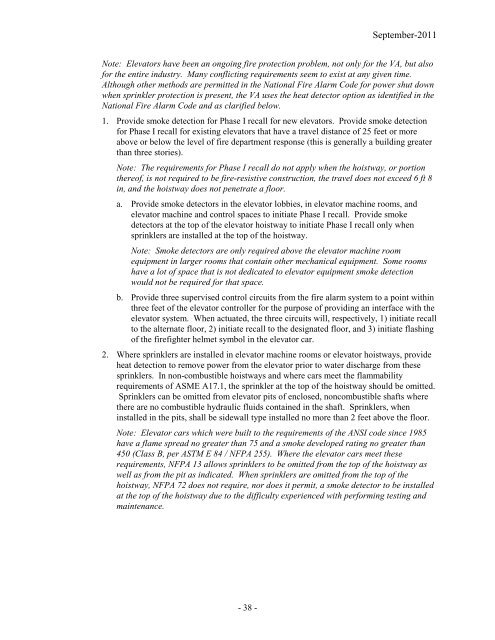Fire Protection Design Manual - Office of Construction and Facilities ...
Fire Protection Design Manual - Office of Construction and Facilities ...
Fire Protection Design Manual - Office of Construction and Facilities ...
Create successful ePaper yourself
Turn your PDF publications into a flip-book with our unique Google optimized e-Paper software.
September-2011<br />
Note: Elevators have been an ongoing fire protection problem, not only for the VA, but also<br />
for the entire industry. Many conflicting requirements seem to exist at any given time.<br />
Although other methods are permitted in the National <strong>Fire</strong> Alarm Code for power shut down<br />
when sprinkler protection is present, the VA uses the heat detector option as identified in the<br />
National <strong>Fire</strong> Alarm Code <strong>and</strong> as clarified below.<br />
1. Provide smoke detection for Phase I recall for new elevators. Provide smoke detection<br />
for Phase I recall for existing elevators that have a travel distance <strong>of</strong> 25 feet or more<br />
above or below the level <strong>of</strong> fire department response (this is generally a building greater<br />
than three stories).<br />
Note: The requirements for Phase I recall do not apply when the hoistway, or portion<br />
there<strong>of</strong>, is not required to be fire-resistive construction, the travel does not exceed 6 ft 8<br />
in, <strong>and</strong> the hoistway does not penetrate a floor.<br />
a. Provide smoke detectors in the elevator lobbies, in elevator machine rooms, <strong>and</strong><br />
elevator machine <strong>and</strong> control spaces to initiate Phase I recall. Provide smoke<br />
detectors at the top <strong>of</strong> the elevator hoistway to initiate Phase I recall only when<br />
sprinklers are installed at the top <strong>of</strong> the hoistway.<br />
Note: Smoke detectors are only required above the elevator machine room<br />
equipment in larger rooms that contain other mechanical equipment. Some rooms<br />
have a lot <strong>of</strong> space that is not dedicated to elevator equipment smoke detection<br />
would not be required for that space.<br />
b. Provide three supervised control circuits from the fire alarm system to a point within<br />
three feet <strong>of</strong> the elevator controller for the purpose <strong>of</strong> providing an interface with the<br />
elevator system. When actuated, the three circuits will, respectively, 1) initiate recall<br />
to the alternate floor, 2) initiate recall to the designated floor, <strong>and</strong> 3) initiate flashing<br />
<strong>of</strong> the firefighter helmet symbol in the elevator car.<br />
2. Where sprinklers are installed in elevator machine rooms or elevator hoistways, provide<br />
heat detection to remove power from the elevator prior to water discharge from these<br />
sprinklers. In non-combustible hoistways <strong>and</strong> where cars meet the flammability<br />
requirements <strong>of</strong> ASME A17.1, the sprinkler at the top <strong>of</strong> the hoistway should be omitted.<br />
Sprinklers can be omitted from elevator pits <strong>of</strong> enclosed, noncombustible shafts where<br />
there are no combustible hydraulic fluids contained in the shaft. Sprinklers, when<br />
installed in the pits, shall be sidewall type installed no more than 2 feet above the floor.<br />
Note: Elevator cars which were built to the requirements <strong>of</strong> the ANSI code since 1985<br />
have a flame spread no greater than 75 <strong>and</strong> a smoke developed rating no greater than<br />
450 (Class B, per ASTM E 84 / NFPA 255). Where the elevator cars meet these<br />
requirements, NFPA 13 allows sprinklers to be omitted from the top <strong>of</strong> the hoistway as<br />
well as from the pit as indicated. When sprinklers are omitted from the top <strong>of</strong> the<br />
hoistway, NFPA 72 does not require, nor does it permit, a smoke detector to be installed<br />
at the top <strong>of</strong> the hoistway due to the difficulty experienced with performing testing <strong>and</strong><br />
maintenance.<br />
- 38

















